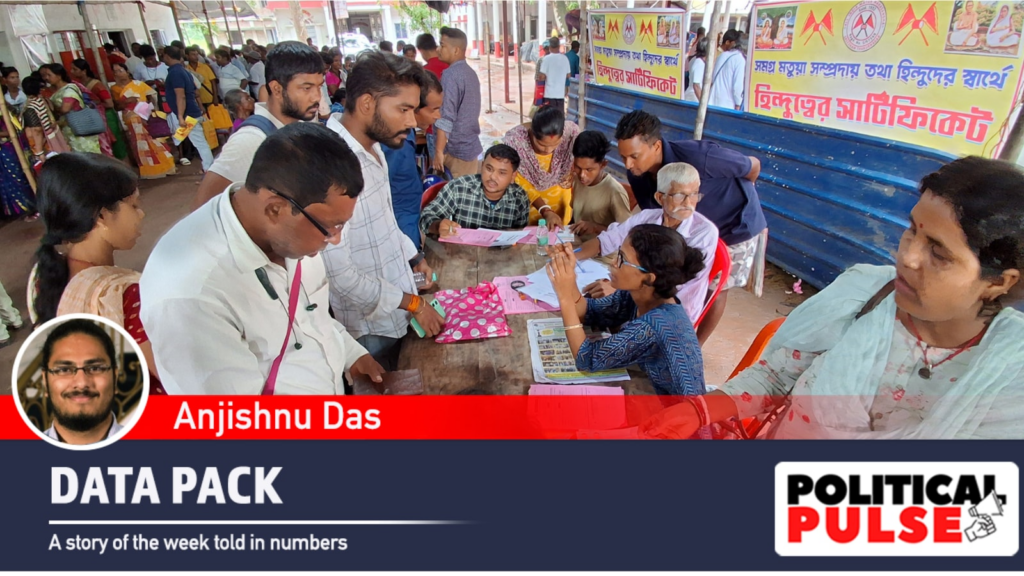The Bengali migrant issue is set to be a hot-button political issue in West Bengal Assembly elections. Accusing states ruled by the BJP of going after Bengali-speaking people on the suspicion of being illegal Bangladeshi immigrants, the West Bengal government led by Mamata Banerjee earlier this week announced a new financial scheme to grant returning migrant families Rs 5,000 per month for a year.
“In the double-engine government states, Bengali migrant workers are being attacked in a planned manner. They are being detained, jailed, and even deported to Bangladesh. Our 22 lakh migrant workers work in other states. We have decided to stand by those who have been tortured and are returning to West Bengal without anything,” the Chief Minister said on Monday.
The 2011 Census, the last such exercise, indicated that there were 24.06 lakh migrants from Bengal spread across India, with Jharkhand, Maharashtra, Uttar Pradesh, Bihar and Delhi the top destinations. The Census data also showed that India has 9.72 crore Bengali speakers, of whom 1.8 crore live outside West Bengal.
Migrants from Bengal
The 2011 Census showed that while Bengal saw substantial migration outside the state, it wasn’t among the top states in this regard. Uttar Pradesh (1.23 crore), Bihar (74.53 lakh) and Rajasthan (37.57 lakh) had the largest out-migrant populations, with Bengal ranking seventh highest at 24.05 lakh – of whom, incidentally, women comprised 14.52 lakh and men 9.53 lakh.
If 5.43 crore total inter-state migrants accounted for 4.5% of the country’s population in 2011, Bengal’s out-migrants counted for 2.63% of its population then.
Neighbouring Jharkhand had the largest population of migrants from Bengal at 4.95 lakh, followed by Maharashtra at 3.1 lakh, Uttar Pradesh at 2.34 lakh. Another bordering state, Bihar, was home to the fourth highest population of migrants from Bengal at 2.28 lakh. Delhi, which has seen a crackdown against Bangladeshis, allegedly leading to the detention of Bengali speakers too in the process, had the fifth highest such population at 1.82 lakh.
In fact, across India, two of the top 50 most popular migration corridors originated from Bengal and ended in Jharkhand and Maharashtra.
Story continues below this ad
[CHART: State-wise population of migrants from Bengal, 2011 Census]
The 2011 Census data also showed a jump of 45% in the number of migrants from Bengal compared to the 2001 Census. In number terms, 7.18 lakh more people left Bengal in this period compared to a decade ago.
In 2011, marriage was the biggest reason for migration from Bengal, with a total 9.35 lakh or 38.88% of the migrants citing this reason. Not surprisingly, women comprised almost all of this number, at 9.14 lakh, compared to just over 20,000 for men. Employment and moving with households were the next biggest reasons for migration, at 5.85 lakh or 24.34% and 4.74 lakh or 19.72% of the migrants, respectively. Education hardly figured, making up 1.1% of the migrants.
[CHART: Reason for migration, 2011 Census]In 2001, too, marriage was the biggest reason for migration, at 5.63 lakh total, followed by employment at 4.52 lakh, and moving with households at 3.62 lakh.
Other data
With the Census data on migration now over a decade out of date, there are some more recent measures of migration that give an indication of numbers leaving Bengal.
Story continues below this ad
The 2016-17 Economic Survey of India used a Cohort-based Migration Metric (CMM) to gauge net migration as the percentage change in population between the 10-19 year-old cohort in an initial Census period and the 20-29 year-old cohort in the same area a decade later. “It is likely to capture labour migration, as other bilateral movements for reasons such as marriage are netted out in the equation,” the report says.
The 2016-17 Economic Survey data showed that UP and Bihar had the highest such net migration, with numbers increasing between 1991-2001 and 2001-11. While Bengal saw about 30,000 people aged 20-29 years leave the state in 1991-2001, this figure rose to 2.35 lakh in 2001-11, the Survey noted.
Last December, a study by the Economic Advisory Council to the Prime Minister (EAC-PM) measured the number of passengers travelling using unreserved or general tickets, which are among the cheapest available, as a proxy for blue collar migrants.
The EAC-PM report used 2023 data to show that Bengal was the third most popular destination for such passengers, after Uttar Pradesh and Maharashtra. But for migrants from Bengal, the most popular destinations were Jharkhand, Assam, Tripura and Bihar (all with substantial Bengali-speaking populations).
Bengali speakers across India
Story continues below this ad
The 2011 Census data on languages, including mother tongues, showed there are far more Bengali speakers across the country than migrants alone.
Of the 9.72 crore people across India who reported Bengali as their mother tongue, 1.8 crore lived outside West Bengal, the 2011 Census showed.
Outside Bengal, the largest Bengali-speaking population was in Assam at 87.87 lakh, followed by Jharkhand at 32.13 lakh, Tripura at 23.31 lakh, Bihar at 8.08 lakh and Odisha at 5.04 lakh.
[CHART: Bengali speakers outside West Bengal, 2011 Census]While many of the states with the most Bengali speakers were concentrated in eastern India around West Bengal, Maharashtra, UP and Delhi had among the highest numbers of Bengali speakers outside the state’s immediate neighbourhood.
Story continues below this ad
As a share of the total state population, while 85.62% of West Bengal’s population counted Bengali as their mother tongue, the next highest proportion of Bengali speakers was in Tripura at 63.43%, followed by Andaman and Nicobar Islands at 28.49%, and Assam at 28.16%.
Only two other states had more than 5% of Bengali speakers – Jharkhand at 9.74% and Meghalaya at 6.43%.
Among the BJP-ruled states where the TMC claims Bengali speakers are being harassed and detained, Delhi had the largest share of Bengali speakers at 1.29% of its population. In Maharashtra and Haryana, Bengali speakers made up 0.39% and 0.28% of the total populations, respectively.

